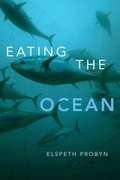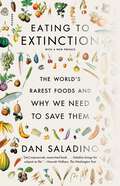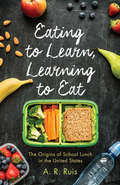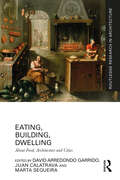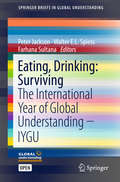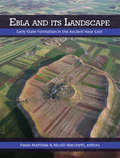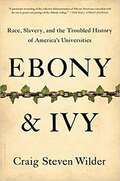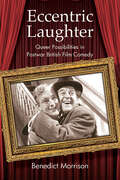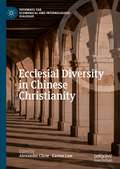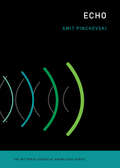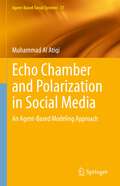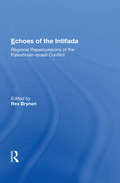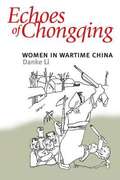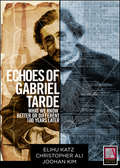- Table View
- List View
Eating on the Move from the Eighteenth Century to the Present (Routledge Studies in Cultural History)
by Peter Scholliers Peter J. Atkins Stefano Magagnoli Rita D’ErricoThis book focuses on food and meals consumed during travel since the transport revolution and examines the ways in which the introduction of new forms of transport (propelled by team and petrol engines), not only affected the way people travel but also led to a transformation in the way we eat. Eating on board a train is different from eating on a ship, and the same is true for other forms of transport. Such differences are not simply a question of quality or variations of menu; a unique history has defined each of these different situations, a history which is still largely to be studied. This volume contains contributions from a mix of established food historians and young researchers. Social and economic history overlap with cultural history approaches and forays into the fields of linguistics and art, confirming that the field of food history, and more generally food studies, is by definition a field of transdisciplinary and border research. This volume will be of interest for scholars within the field of food history, food studies, and food culture, as well as social and cultural historians dealing with industrialization or social policy.
Eating on the Wild Side: The Missing Link to Optimum Health
by Jo RobinsonThe next stage in the food revolution--a radical way to select fruits and vegetables and reclaim the flavor and nutrients we've lost.Eating on the Wild Side is the first book to reveal the nutritional history of our fruits and vegetables. Starting with the wild plants that were central to our original diet, investigative journalist Jo Robinson describes how 400 generations of farmers have unwittingly squandered a host of essential fiber, protein, vitamins, minerals, and antioxidants. New research shows that these losses have made us more vulnerable to our most troubling conditions and diseases--obesity, diabetes, cancer, cardiovascular disease, chronic inflammation, and dementia. In an engaging blend of science and story, Robinson describes how and when we transformed the food in the produce aisles. Wild apples, for example, have from three to 100 times more antioxidants than Galas and Honeycrisps, and are five times more effective in killing cancer cells. Compared with spinach, one of our present-day "superfoods," wild dandelion leaves have eight times more antioxidant activity, two times more calcium, three more times vitamin A, and five times more vitamins K and E. How do we begin to recoup the losses of essential nutrients? By "eating on the wild side"--choosing present-day fruits and vegetables that come closest to the nutritional bounty of their wild ancestors. Robinson explains that many of these jewels of nutrition are hiding in plain sight in our supermarkets, farmers markets, and U-pick orchards. Eating on the Wild Side provides the world's most extensive list of these superlative varieties. Drawing on her five-year review of recently published studies, Robinson introduces simple, scientifically proven methods of storage and preparation that will preserve and even enhance their health benefits: Squeezing fresh garlic in a garlic press and then setting it aside for ten minutes before cooking it will increase your defenses against cancer and cardiovascular disease. Baking potatoes, refrigerating them overnight, and then reheating them before serving will keep them from spiking your blood sugar. Cooking most berries makes them more nutritious. Shredding lettuce the day before you eat it will double its antioxidant activity. Store watermelon on the kitchen counter for up to a week and it will develop more lycopene. Eat broccoli the day you buy it to preserve its natural sugars and cancer-fighting compounds. The information in this surprising, important, and meticulously researched book will prove invaluable for omnivores, vegetarians, and vegans alike, and forever change the way we think about food.
Eating the Dinosaur: An Essay From Eating The Dinosaur (Chuck Klosterman On Rock Ser.)
by Chuck KlostermanAfter a bestselling and acclaimed diversion into fiction, Chuck Klosterman, author of Sex, Drugs, and Cocoa Puffs, returns to the form in which he's been spectacularly successful with a collection of essays about our consumption of pop culture and sports.Q: What is this book about? A: Well, that's difficult to say. I haven't read it yet--I've just picked it up and casually glanced at the back cover. There clearly isn't a plot. I've heard there's a lot of stuff about time travel in this book, and quite a bit about violence and Garth Brooks and why Germans don't laugh when they're inside grocery stores. Ralph Nader and Ralph Sampson play significant roles. I think there are several pages about Rear Window and college football and Mad Men and why Rivers Cuomo prefers having sex with Asian women. Supposedly there's a chapter outlining all the things the Unabomber was right about, but perhaps I'm misinformed. Q: Is there a larger theme? A: Oh, something about reality. "What is reality," maybe? No, that's not it. Not exactly. I get the sense that most of the core questions dwell on the way media perception constructs a fake reality that ends up becoming more meaningful than whatever actually happened. Also, Lady Gaga. Q: Should I read this book? A: Probably. Do you see a clear relationship between the Branch Davidian disaster and the recording of Nirvana's In Utero? Does Barack Obama make you want to drink Pepsi? Does ABBA remind you of AC/DC? If so, you probably don't need to read this book. You probably wrote this book. But I suspect everybody else will totally love it, except for the ones who totally hate it.
Eating the Enlightenment: Food and the Sciences in Paris, 1670–1760
by E.C. SparyEating the Enlightenment offers a new perspective on the history of food, looking at writings about cuisine, diet, and food chemistry as a key to larger debates over the state of the nation in Old Regime France. Embracing a wide range of authors and scientific or medical practitioners—from physicians and poets to philosophes and playwrights—E. C. Spary demonstrates how public discussions of eating and drinking were used to articulate concerns about the state of civilization versus that of nature, about the effects of consumption upon the identities of individuals and nations, and about the proper form and practice of scholarship. En route, Spary devotes extensive attention to the manufacture, trade, and eating of foods, focusing upon coffee and liqueurs in particular, and also considers controversies over specific issues such as the chemistry of digestion and the nature of alcohol. Familiar figures such as Fontenelle, Diderot, and Rousseau appear alongside little-known individuals from the margins of the world of letters: the draughts-playing café owner Charles Manoury, the “Turkish envoy” Soliman Aga, and the natural philosopher Jacques Gautier d’Agoty. Equally entertaining and enlightening, Eating the Enlightenment will be an original contribution to discussions of the dissemination of knowledge and the nature of scientific authority.
Eating the Ocean
by Elspeth ProbynIn Eating the Ocean Elspeth Probyn investigates the profound importance of the ocean and the future of fish and human entanglement. On her ethnographic journey around the world's oceans and fisheries, she finds that the ocean is being simplified in a food politics that is overwhelmingly land based and preoccupied with buzzwords like "local" and "sustainable." Developing a conceptual tack that combines critical analysis and embodied ethnography, she dives into the lucrative and endangered bluefin tuna market, the gendered politics of "sustainability," the ghoulish business of producing fish meal and fish oil for animals and humans, and the long history of encounters between humans and oysters. Seeing the ocean as the site of the entanglement of multiple species--which are all implicated in the interactions of technology, culture, politics, and the market--enables us to think about ways to develop a reflexive ethics of taste and place based in the realization that we cannot escape the food politics of the human-fish relationship.
Eating to Extinction: The World's Rarest Foods and Why We Need to Save Them
by Dan SaladinoDan Saladino's Eating to Extinction is the prominent broadcaster’s pathbreaking tour of the world’s vanishing foods and his argument for why they matter now more than everOver the past several decades, globalization has homogenized what we eat, and done so ruthlessly. The numbers are stark: Of the roughly six thousand different plants once consumed by human beings, only nine remain major staples today. Just three of these—rice, wheat, and corn—now provide fifty percent of all our calories. Dig deeper and the trends are more worrisome still:The source of much of the world’s food—seeds—is mostly in the control of just four corporations. Ninety-five percent of milk consumed in the United States comes from a single breed of cow. Half of all the world’s cheese is made with bacteria or enzymes made by one company. And one in four beers drunk around the world is the product of one brewer.If it strikes you that everything is starting to taste the same wherever you are in the world, you’re by no means alone. This matters: when we lose diversity and foods become endangered, we not only risk the loss of traditional foodways, but also of flavors, smells, and textures that may never be experienced again. And the consolidation of our food has other steep costs, including a lack of resilience in the face of climate change, pests, and parasites. Our food monoculture is a threat to our health—and to the planet. In Eating to Extinction, the distinguished BBC food journalist Dan Saladino travels the world to experience and document our most at-risk foods before it’s too late. He tells the fascinating stories of the people who continue to cultivate, forage, hunt, cook, and consume what the rest of us have forgotten or didn’t even know existed. Take honey—not the familiar product sold in plastic bottles, but the wild honey gathered by the Hadza people of East Africa, whose diet consists of eight hundred different plants and animals and who communicate with birds in order to locate bees’ nests. Or consider murnong—once the staple food of Aboriginal Australians, this small root vegetable with the sweet taste of coconut is undergoing a revival after nearly being driven to extinction. And in Sierra Leone, there are just a few surviving stenophylla trees, a plant species now considered crucial to the future of coffee.From an Indigenous American chef refining precolonial recipes to farmers tending Geechee red peas on the Sea Islands of Georgia, the individuals profiled in Eating to Extinction are essential guides to treasured foods that have endured in the face of rampant sameness and standardization. They also provide a roadmap to a food system that is healthier, more robust, and, above all, richer in flavor and meaning.
Eating to Learn, Learning to Eat: The Origins of School Lunch in the United States
by Andrew R. RuisIn Eating to Learn, Learning to Eat, historian A. R. Ruis explores the origins of American school meal initiatives to explain why it was (and, to some extent, has continued to be) so difficult to establish meal programs that satisfy the often competing interests of children, parents, schools, health authorities, politicians, and the food industry. Through careful studies of several key contexts and detailed analysis of the policies and politics that governed the creation of school meal programs, Ruis demonstrates how the early history of school meal program development helps us understand contemporary debates over changes to school lunch policies.
Eating with the Tudors: Food and Recipes
by Brigitte WebsterDive right into this extensive collection of authentic Tudor recipes, from suckling pigs to pax cakes! Eating with the Tudors is an extensive collection of authentic Tudor recipes that tell the story of a dramatically changing world in sixteenth-century England. This book highlights how religion, reformation and politics influenced what was served on a Tudor’s dining table from the very beginning of Henry VII’s reign to the final days of Elizabeth I’s rule. Discover interesting little food snippets from Tudor society, carefully researched from household account books, manuscripts, letters, wills, diaries and varied works by Tudor physicians, herbalists and chronologists. Find out about the Tudor’s obsession with food and uncover which key ingredients were the most popular choice. Rediscover old Tudor favorites that once again are being celebrated in trendy restaurants and learn about the new, exotic food that excited and those foods that failed to meet the Elizabethan expectations. Eating with the Tudors explains the whole concept of what a healthy balanced meal meant to the people of Tudor England and the significance and symbology of certain food and its availability throughout the year. Gain an insight into the world of Tudor food, its role to establish class, belonging and status and be tempted to re-create some iconic Tudor flavors and experience for yourself the many varied and delicious seasonal tastes that Tudor dishes have to offer. Spice up your culinary habits and step back in time to recreate a true Tudor feast by impressing your guests the Tudor way or prepare a New Year’s culinary gift fit for a Tudor monarch.
Eating, Building, Dwelling: About Food, Architecture and Cities (Routledge Research in Architecture)
by Marta Sequeira David Arredondo Garrido Juan CalatravaThe intricate relationship between food, city and architecture, spanning from ancient civilizations to the present, serves as a focal point for interdisciplinary discourse. This book delves into a diverse set of cases throughout history in which processes related to food significantly influenced architectural or urban designs.This book delineates three spatial levels — city, home and intermediate spaces — illuminating their dynamic interplay within the construct of a continually evolving “food space." Featuring 12 contributions from Mediterranean Europe, this publication explores historical legacies and contemporary challenges. Divided into urban-territorial and architectural scales, it offers nuanced insights into urban dynamics, domestic life and gastronomic tourism. Supported by a prestigious introductory study, this research advances a comprehensive understanding of food's role in shaping urban environments.Through the chapters of this book, those interested in cultural studies of food, urban history and architecture will be able to reflect on our relationship with food and its processes, and how it affects the way we live and design our cities and their architectures.
Eating, Drinking: Surviving
by Peter Jackson Walter E.L. Spiess Farhana SultanaThis publication addresses the global challenges of food and water security in a rapidly changing and complex world. The essays highlight the links between bio-physical and socio-cultural processes, making connections between local and global scales, and focusing on the everyday practices of eating and drinking, essential for human survival. Written by international experts, each contribution is research-based but accessible to the general public.
Eavesdropping: The psychotherapist in film and television
by Lucy Huskinson Terrie WaddellWhat can depictions of psychotherapy on screen teach us about ourselves? In Eavesdropping, a selection of contributions from internationally-based film consultants, practicing psychotherapists and interdisciplinary scholars investigate the curious dynamics that occur when films and television programmes attempt to portray the psychotherapist, and the complexities of psychotherapy, for popular audiences. The book evaluates the potential mismatch between the onscreen psychotherapist, whose raison d’être is to entertain and engage global audiences, and the professional, real-life counterpart, who becomes intimately involved with the dramas of their patients. While several contributors conclude that actual psychotherapy, and the way psychotherapists and their clients grapple with notions of fantasy and reality, would make a rather poor show, Eavesdropping demonstrates the importance of psychotherapy and psychotherapists on-screen in assisting us to wrestle with the discomfort – and humour - of our lives. Offering a unique insight into perceptions of psychotherapy, Eavesdropping will be essential and insightful reading for analytical psychologists, psychoanalysts, academics and students of depth psychology, film and television studies, media studies and literature, as well as filmmakers.
Ebb and Flow: How to Connect with the Patterns and Power of Water
by Easkey BrittonAn exploration of water's power to heal us, inspire us and offer us spiritual meaning. This is a feminist reimagining of the meaning of power through the lens of water. Easkey offers a range of wellness practices to encourage the reader to connect with water as healer, restoring a relationship of care.Our strength lies in being soft like water. This book is about the power we gain by connecting to water. It&’s about how we can restore our relationship with the world's different bodies of water, and by doing so, restore both the water and ourselves. By sharing Easkey's own experiences as surfer and marine scientist, as well as those of many of her mentors who are at the forefront of water protection and activism around the world, it guides readers into reimagining the spirituality of water and restoring our innate connection with this lifeblood of the planet.The book also provides the reader with water-inspired strategies to restore calm, reduce stress and soothe anxiety. These range from simple breathing and visualization exercises to undertaking a journey from a water source to the ocean in order to forge a deep connection with the water. The emphasis is as much on the benefit to water as it is to the individual, and on creating a culture of reciprocity and care. By regaining this lost connection with water, we learn to develop an empathic connection with the force of all life and in the process restore our own hearts and minds.
Ebby: The Man Who Sponsored Bill W.
by Mel B.This is both a fascinating history of the formative years of Alcoholics Anonymous, as well as the bitter-sweet tale of the troubled man Bill W. always referred to as "my sponsor."In 1934, Ebby Thatcher called an old drinking buddy to tell him about the happiness he was finding in sobriety. His friend's name was Bill Wilson, and this book is the story of their life-long friendship. It is both a fascinating history of the formative years of Alcoholics Anonymous, as well as the bitter-sweet tale of the troubled man Bill W. always referred to as "my sponsor.""Deeply informative and moving, a valuable contribution to the history of A.A. A 'must' reading for anyone interested in one of the more fascinating chapters in A.A.'s history."--Nell Wing, Retired A.A. Archivist and Bill Wilson's Secretary
Ebla and its Landscape: Early State Formation in the Ancient Near East
by Paolo Matthiae Nicolò MarchettiThe discovery of 17,000 tablets at the mid-third millennium BC site of Ebla in Syria has revolutionized the study of the ancient Near East. This is the first major English-language volume describing the multidisciplinary archaeological research at Ebla. Using an innovative regional landscape approach, the 29 contributions to this expansive volume examine Ebla in its regional context through lenses of archaeological, textual, archaeobiological, archaeometric, geomorphological, and remote sensing analysis. In doing so, they are able to provide us with a detailed picture of the constituent elements and trajectories of early state development at Ebla, essential to those studying the ancient Near East and to other archaeologists, historians, anthropologists, and linguists. This work was made possible by an IDEAS grant from the European Research Council.
Ebony Magazine and Lerone Bennett Jr.: Popular Black History in Postwar America
by E. James WestFrom its launch in 1945, Ebony magazine was politically and socially influential. However, the magazine also played an important role in educating millions of African Americans about their past. Guided by the pen of Lerone Bennett Jr., the magazine’s senior editor and in-house historian, Ebony became a key voice in the popular black history revival that flourished after World War II. Its content helped push representations of the African American past from the margins to the center of the nation’s cultural and political imagination. E. James West's fresh and fascinating exploration of Ebony’s political, social, and historical content illuminates the intellectual role of the iconic magazine and its contribution to African American scholarship. He also uncovers a paradox. Though Ebony provided Bennett with space to promote a militant reading of black history and protest, the magazine’s status as a consumer publication helped to mediate its representation of African American identity in both past and present. Mixing biography, cultural history, and popular memory, West restores Ebony and Bennett to their rightful place in African American intellectual, commercial, and political history.
Ebony and Ivy: Race, Slavery, and the Troubled History of America's Universities
by Craig Steven WilderA 2006 report commissioned by Brown University revealed that institution's complex and contested involvement in slavery--setting off a controversy that leapt from the ivory tower to make headlines across the country. But Brown's troubling past was far from unique. In Ebony and Ivy, Craig Steven Wilder, a rising star in the profession of history, lays bare uncomfortable truths about race, slavery, and the American academy. <P><P> Many of America's revered colleges and universities--from Harvard, Yale, and Princeton to Rutgers, Williams College, and UNC--were soaked in the sweat, the tears, and sometimes the blood of people of color. Slavery funded colleges, built campuses, and paid the wages of professors. Enslaved Americans waited on faculty and students; academic leaders aggressively courted the support of slave owners and slave traders. Significantly, as Wilder shows, our leading universities, dependent on human bondage, became breeding grounds for the racist ideas that sustained them. Ebony and Ivy is a powerful and propulsive study and the first of its kind, revealing a history of oppression behind the institutions usually considered the cradle of liberal politics.
Ecce Humanitas: Beholding the Pain of Humanity (Insurrections: Critical Studies in Religion, Politics, and Culture)
by Brad EvansThe very idea of humanity seems to be in crisis. Born in the ashes of devastation after the slaughter of millions, the liberal conception of humanity imagined a suffering victim in need of salvation. Today, this figure appears less and less capable of galvanizing the political imagination. But without it, how are we to respond to the inhumane violence that overwhelms our political and philosophical registers? How can we make sense of the violence that was carried out in the name of humanism? And how can we develop more ethical relations without becoming parasitic on the pain of others?Through a critical exploration of violence and the sacred, Ecce Humanitas recasts the fall of liberal humanism. Brad Evans offers a rich analysis of the changing nature of sacrificial violence, from its theological origins to the exhaustion of the victim in the contemporary world. He critiques the aestheticization that turns victims into sacred objects, sacrificial figures that demand response, perpetuating a cycle of violence that is seen as natural and inevitable. In novel readings of classic and contemporary works, Evans traces the sacralization of violence as well as art’s potential to incite resistance. Countering the continued annihilation of life, Ecce Humanitas calls for liberating the political imagination from the scene of sacrifice. A new aesthetics provides a form of transgressive witnessing that challenges the ubiquity of violence and allows us to go beyond humanism to imagine a truly liberated humanity.
Eccentric Laughter: Queer Possibilities in Postwar British Film Comedy (SUNY series, Horizons of Cinema)
by Benedict MorrisonEccentric Laughter explores new ways to watch postwar British film comedies, arguing that their representations of eccentricity offered a set of possible queer futures for a Britain that had been destabilized by years of conflict and social upheaval. Far from being the apolitical cinema described by previous critics, these comedies—including both perennial favorites from Ealing Studios and neglected films ripe for rediscovery—make a joke of and suggest alternatives to the heterocentric home and family. Referencing a wide range of theories, the book gives details of how these films' comic queernesses are not structured on fixed identities but on an open play of possibilities, depicting eccentricity, artifice, drag, ruins, and the wild in ways that can still offer inspiration for experiments in living today. Engaging with contemporary queer theories and politics, the book argues that these films continue to address questions of urgent relevance to students and other viewers in the twenty-first century. Films discussed include The Belles of St. Trinian's, Genevieve, The Lavender Hill Mob, Simon and Laura, The Stranger Left No Card, and Young Wives' Tale.
Ecclesial Diversity in Chinese Christianity (Pathways for Ecumenical and Interreligious Dialogue)
by Alexander Chow Easten LawThis volume explores Chinese Christianity—or Chinese Christianities—in a variety of forms and expressions, including those from outside the geopolitical boundaries of mainland China. Advancing a multi-disciplinary approach to the study of Chinese churches, the essays collected here engage many historical, sociological, cultural, and theological contingencies. The collection includes historical discussions of the early-20th-century encounters of Protestant and Catholic missionaries in China and the rise of Christianity among Malaysian Chinese and British Chinese communities. Essays examine the thinking of K. H. Ting (or Ding Guangxun), often remembered for his leadership in the Three-Self Patriotic Movement in the 1980s–90s, by revisiting his earlier theology and approach to the Bible in the 1930s–50s. These retrospectives give way to contemporary explorations into how Chinese churches negotiate their urban identities amidst the complexities of globalization in Chengdu and Shanghai, as well as in Vancouver, Canada. Taken as a whole, this collection offers close examinations into various aspects of Chinese Christianity’s complex picture, helping readers to recognize the many shades and colors of the global Chinese Church.
Echo (The MIT Press Essential Knowledge series)
by Amit PinchevskiAn exploration of echo not as simple repetition but as an agent of creative possibilities.In this volume in the MIT Press Essential Knowledge series, Amit Pinchevski proposes that echo is not simple repetition and the reproduction of sameness but an agent of change and a source of creation and creativity. Pinchevski views echo as a medium, connecting and mediating across and between disparate domains. He reminds us that the mythological Echo, sentenced by Juno to repeat the last words of others, found a way to make repetition expressive. So too does echo introduce variation into sameness, mediating between self and other, inside and outside, known and unknown, near and far. Echo has the potential to bring back something unexpected, either more or less than what was sent. Pinchevski distinguishes echo from the closely related but sometimes conflated reflection, reverberation, and resonance; considers echolalia as an active, reactive, and creative vocalic force, the launching pad of speech; and explores echo as a rhetorical device, steering between appropriation and response while always maintaining relation. He examines the trope of echo chamber and both destructive and constructive echoing; describes various echo techniques and how echo can serve practical purposes from echolocation in bats and submarines to architecture and sound recording; explores echo as a link to the past, both literally and metaphorically; and considers echo as medium using Marshall McLuhan&’s tetrad.
Echo Chamber and Polarization in Social Media: An Agent-Based Modeling Approach (Agent-Based Social Systems #17)
by Muhammad Al AtiqiThis book addresses increasingly relevant social problems enabled by social media through the lens of system science research and modeling. Instead of evaluating existing patterns from existing social media data, the book focuses on exploring the possibility of various policies. Specifically, it provides fresh insight into the political echo chamber and polarization in social media using agent-based modeling and scenario analysis. The book contains a practical framework to study the factors influencing echo chambers and polarization formation occurring in social media communication. By modeling individual social media users' information consumption, the influence of various behaviors and policies are captured as macro-phenomena. The book also introduces a comprehensive agent-based reinterpretation of the Zaller model, a classic in public opinion research. In addition, the book demonstrates two real-life applications of the model using empirical observations: resolving the conflicting observations of the online echo chamber effect, and modeling the influence of vaccine-related Facebook pages on users’ opinions about vaccination.
Echoes Of The Intifada: Regional Repercussions Of The Palestinian-israeli Conflict
by Rex BrynenImportant historical turning points often seem to be unpredicted until they are upon us. For most observers (the author included) the Palestinian uprising that erupted in December 1987 was unexpected-not because the depth of Palestinian national aspirations or the growing strength of Palestinian socio-political organization under occupation were un
Echoes of Chongqing: Women in Wartime China
by Danke LiThis collection of annotated oral histories records the personal stories of twenty Chinese women who lived in the wartime capital of Chongqing during China's War of Resistance against Japan during World War II. By presenting women's remembrances of the war, this study examines the interplay between oral history and traditional historical narrative, public discourse, and private memories. The women interviewed came from differing social, economic, and educational backgrounds and experienced the war in a variety of ways, some of them active in the communist resistance and others trying to support families or pursue educations in the face of wartime upheaval. Their stories demonstrate that the War of Resistance had two faces: one presented by official propaganda and characterized by an upbeat unified front against Japan, the other a record of invisible private stories and a sobering national experience of death and suffering. The accounts of how women coped, worked, and lived during the war years in the Chongqing region recast historical understanding of the roles played by ordinary people in wartime and give women a public voice and face that, until now, have been missing from scholarship on the war.
Echoes of Gabriel Tarde: What We Know Better or Different 100 Years Later
by Larry Gross Arlene Luck Christopher Ali Elihu Katz Joohan KimOriginally published in 1898, Gabriel Tarde's essay "Opinion and Conversation" can be read as a series of propositions about the interaction of press, conversation, opinion and action, anticipating today's "deliberative democracy." Exploring these themes in a hyper-text "dialogue" with Tarde, Elihu Katz, Christopher Ali, and Joohan Kim ask what we know better or different 100 years later in this book. The aim is not only to reawaken attention to Tarde's text, but to assess the progress of communications research in its light. The e-book's format makes it possible to access the essay as a series of propositions, foreshadowing contemporary concerns with issues such as agenda setting, public opinion formation, the diffusion of innovation, the two-step flow of communication, the role of the press in nation-building, new media technologies, the normative role of media in a democracy, media events, and the like. The e-book includes an analytic Introduction, a biographical postscript and the first full English translation of Tarde's essay. Long overlooked, "Opinion and Conversation" deserves to be canonized as foundational for theories that link mass and interpersonal communication, especially in the age of social media. Authors are Elihu Katz, Distinguished Trustee Professor of the Annenberg School for Communication at the University of Pennsylvania, Christopher Ali, Assistant Professor of Communication at the University of Virginia, and Joohan Kim, Professor of Communication at Yonsei University in South Korea. Louise Salmon of the Sorbonne (Paris 1) contributed the biographical note.




